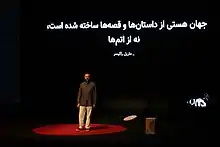Mohammad Jafar Mahallati
Mohammad Jafar Mahallati is an Iranian scholar of Islamic studies and a former diplomat. He is currently serving as the Nancy Schrom Dye Chair in Middle East and North African Studies at Oberlin College in Oberlin, Ohio. During 1987-89, he served as the Iran's ambassador and Permanent Representative to the United Nations.[1][2]

Life
Born in Tehran, Mahallati initially studied economics at the National University of Iran and civil engineering at the University of Kansas in the US. Later, he obtained a master's in political economy from the University of Oregon and earned his PhD in Islamic studies from McGill University in Canada. Serving as the chair of the department of economics in Kerman University for a year, Mahallati became a diplomat and spent a decade working with the United Nations. He played a major role in adopting the Security Council Resolution 598 which brought the Iran-Iraq war to an end. Returning to his academic career, Mahallati taught at various institutions including Columbia, Princeton, Yale, and Georgetown. In 2007, he joined the Oberlin College and is still serving as the Presidential Scholar in Islamic Studies and the Nancy Schrom Dye Chair in Middle East and North African Studies.[3]
Accusation
On the 7th of October 2020, a group of former Iranian political prisoners and human rights activists sent a letter to the president of Oberlin College demanding that the college's management terminate Dr. Mohammad Jafar Mahallati's employment following accusations he played a role in the cover-up of the 1988 massacre of political prisoners in Iran.[4] Mahallati served as the Director General of International Affairs for the Iranian Foreign Ministry from 1982 to 1987 and Chargé d'Affaires and the Ambassador of Iran to the United Nations from 1987-1989.
On 10 October Dr. Mahallati wrote in a statement "The accusers fail to provide a single solid document as evidence of my actual knowledge of these incidents. With no concrete evidence, they infer that I must have been informed of and intentionally denied these atrocities. I categorically deny any knowledge and therefore responsibility regarding mass executions in Iran when I was serving at the United Nations."[5]
However, on 16 August 1988 Amnesty International sent a letter of "Urgent Action| to the Chief Justice and Minister of Justice of Iran, expressing concern with evidence that a new wave of political executions were taking place in Iran of which copies were sent to the diplomatic representatives of Iran around the world .[6] On 2 September 1988, Amnesty International once again sent a letter of Urgent Action to the same authorities and Iranian diplomatic representatives, condemning the political executions in Iran in August, which were reportedly continuing.[7]
Between August and December 1988, Amnesty International sent 14 letters of Urgent Action to the Iranian authorities and diplomatic representatives requesting that the mass executions of political prisoners be stopped[8]
On 13 October 1988 at the UN general assembly, Prof.Qalindo Pohl Special Representative of the Commission on Human Rights in Iran presented his report about human right violations and executions in Iran.[9]
According to the UN report, on the 20 November 1988, the Special Representative had a long discussion with the Ambassador Mahallati and a second meeting took place on 29 November, at which the Ambassador Mahallati referred to the alleged wave of executions mentioned in the interim report of Prof. Qalindo Pohl and denied the allegations.[10] On the 8 December 1988, while Mr Mahallati was the Ambassador, the UN General Assembly adopted a resolution on the situation of human rights in Iran, which expressed grave concern about a renewed wave of executions in Iran in July-September 1988 targeting prisoners for their political convictions.[11]
On 26 January 1989, the UN Special Representative on human rights in Iran challenged Iran’s “global denial” of the wave of executions. He submitted a list of 1,084 name to the Iranian authorities asking for information on their fate and whereabouts and noted that “there were in all probability several thousand victims”[12]
Works
- Ethics of War and Peace in Iran and Shi'i Islam (University of Toronto Press, Scholarly Publishing Division, Nov 14, 2016)
- Friendship in Islamic Ethics and World Politics (the University of Michigan Press, 2019)
References
- Boustany, Nora (1988-07-05). "ARAB STATES HOPE TRAGEDY CAN LEAD TO PEACE IN GULF". Washington Post. ISSN 0190-8286. Retrieved 2019-12-17.
- "UN CONFIRMS IRAN'S EFFORTS TO END CRISIS - CSMonitor.com". www.csmonitor.com. Retrieved 2019-12-17.
- "Mohammad Jafar Mahallati, Religion Professor". The Oberlin Review. Retrieved 2019-12-17.
- "Iranian diplomat turned US professor accused of crimes against humanity". The Jerusalem Post. Retrieved 2020-10-09.
- Mahallati, Mohammad Jafar. "Statement in Response to Allegations of Covering Up Iranian Executions". The Oberlin Review. Retrieved 2020-10-09.
- "UA 219/88 Iran: Death Penalty: Political Executions" (pdf). www.amnesty.org. 16 August 1988. Retrieved 2020-10-11.
- "UA 235/88 Iran: Death Penalty: Political Executions" (pdf). www.amnesty.org. 2 September 1988. Retrieved 2020-10-11.
- "Death Penalty Urgent Action". www.amnesty.org. Retrieved 2020-10-12.
- Galindo Pohl, Reynaldo (1988-10-13). "Situation of human rights in the Islamic Republic of Iran :". United Nations Digital Library System.
- "Report on the human rights situation in the Islamic Republic of Iran by the Special Representative of the Commission on Human Rights, Mr. Reynaldo Pohl, pursuant to Commission resolution 1988/69". Iran Human Rights Documentation Center. 1988-01-26. Retrieved 2020-10-09.
- Refugees, United Nations High Commissioner for. "Refworld | Situation of human rights in the Islamic Republic of Iran : resolution / adopted by the General Assembly". Refworld. Retrieved 2020-10-09.
- "Iran: Blood Soaked Secrets". www.amnesty.org. 4 December 2018. Retrieved 2020-10-09.